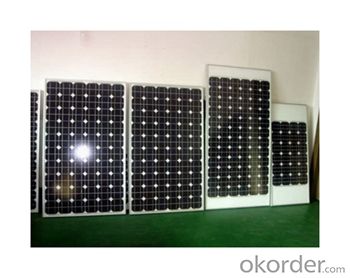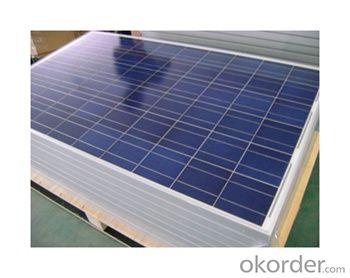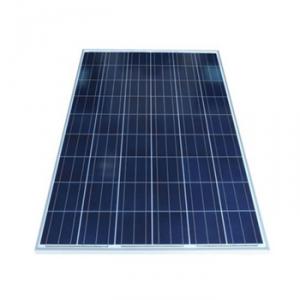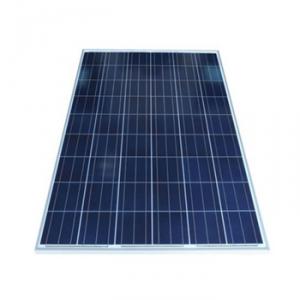Solar Modulels Poly-crystalline 220W156*156 Module
- Loading Port:
- China Main Port
- Payment Terms:
- TT or LC
- Min Order Qty:
- -
- Supply Capability:
- -
OKorder Service Pledge
OKorder Financial Service
You Might Also Like
Solar Module Descriptions:
Solar Power Modules (known as Photovoltaics - PV) can generate electricity for your home or business, either as part of a stand-alone solar power system, or for buildings already connected to the local electricity network.
PV systems use the most abundant energy source on the planet, solar radiation, to generate electricity. They are silent, consume no fuel and generate no pollution. They also contribute to the reduction of greenhouse gas emissions; a 2kW PV system on a house will prevent the emission of about 40 tonnes of CO2 during its projected 30 year lifetime. Furthermore, the use of PV will reduce your electricity bills and exposure to fluctuating and steadily rising electricity prices.


Electrical Characteristics
Max-power (W) | 220 |
Max-Power Voltage (V) | 29.20 |
Max-Power Current (A) | 7.53 |
Open-Circuit Voltage (V) | 36.10 |
Short-Circuit Current (A) | 7.98 |
Mechanical Characteristics
Cable type, Diameter and Length | 4mm2, TUV certified, 1000mm |
Type of Connector | Compatible with MC4 plug |
Arrangement of cells | 6*10 |
Cell Size | 156*156 |
Dimension | 1580*1069*45 |
Weight | 19.5Kg |
Glass, Type and Thickness | High Transmission, Low Iron, Tempered Glass 3.2mm |
Features
Guaranteed positive tolerance 0/+5w ensures power output reliability
Strong aluminum frames module can bear snow loads up to 5400Pa and wind loads up to 2400Pa.
Excellent performance under low light environments (mornings evenings and cloudy days)
12 years for product defects in materials and workmanship and 25 years for 80% of warranted minimum power.
Certifications and standards: IEC 61215.
Manufactured according to International Quality and Environment Management System (ISO9001, ISO14100).
FAQ
Q: What kind of loads can I run on PV?
With a correctly designed PV system you can power almost any electrical load. However, as the load size increases the expense also increases. Loads like hot water heaters, air conditioners, room heaters and electric stoves should be avoided. The added cost of trying to power loads like these is very cost prohibitive. If these loads have to be powered it will be a lot less expensive to change the appliance to use an alternative fuel type like propane.
Q: When do I need a charge controller and why?
The safest way to figure out if you need a charge controller is to take Battery Amp Hour Capacity and divide this by the Solar Panel max. power amp rating. If the quotient is above 200, you don't need a controller. If the number is less than 200 than you need a controller.
- Q:Can a solar inverter be used with different types of backup power sources?
- Yes, a solar inverter can be used with different types of backup power sources. Solar inverters are designed to convert the DC power generated by solar panels into AC power that can be used to power household appliances and devices. They can be connected to various backup power sources like batteries, generators, or the grid to provide uninterrupted power supply during periods of low sunlight or power outages.
- Q:How do you connect a solar inverter to solar panels?
- To connect a solar inverter to solar panels, the DC output of the solar panels needs to be connected to the DC input of the inverter. This is usually done using appropriately sized and rated solar cables and connectors. The positive terminal of the solar panel is connected to the positive terminal of the inverter, and the negative terminal of the solar panel is connected to the negative terminal of the inverter. Properly following the manufacturer's instructions and guidelines is crucial to ensure a safe and efficient connection.
- Q:How does a solar inverter work?
- A solar inverter works by converting the direct current (DC) electricity produced by solar panels into alternating current (AC) electricity that can be used to power household appliances and be connected to the electric grid. It also ensures that the solar panels operate at their maximum efficiency by tracking the maximum power point and optimizing the power output.
- Q:How does a solar inverter handle voltage fluctuations from the grid?
- A solar inverter handles voltage fluctuations from the grid by continuously monitoring the grid voltage and adjusting its output accordingly. When the grid voltage fluctuates, the inverter uses its internal control mechanisms to stabilize the output voltage, ensuring a consistent and stable supply of electricity to the connected solar panels or the grid. This helps protect the solar system from potential damage caused by voltage variations and allows for efficient power generation and distribution.
- Q:What is the maximum number of solar panels that can be connected to a solar inverter?
- The maximum number of solar panels that can be connected to a solar inverter depends on various factors such as the power rating and specifications of the inverter, the total power capacity of the solar panels, and the design of the solar power system. It is best to consult the manufacturer's guidelines or a professional solar installer to determine the appropriate number of solar panels that can be connected to a specific solar inverter.
- Q:Can a solar inverter be used with solar concentrators?
- Yes, a solar inverter can be used with solar concentrators. Solar concentrators focus sunlight onto a smaller area, increasing the intensity of the light. The solar inverter's primary function is to convert the DC power generated by the solar panels into AC power suitable for use in homes or businesses. Therefore, it can still be used to convert the enhanced DC power generated by solar concentrators into usable AC power.
- Q:What is the role of voltage regulation in a solar inverter?
- The role of voltage regulation in a solar inverter is to ensure that the energy generated by the solar panels is converted and delivered to the electrical grid or used within a premises at a stable and appropriate voltage level. It helps to maintain the quality and consistency of the electricity output, protecting the connected devices and ensuring optimal performance of the solar power system.
- Q:How does a solar inverter handle voltage and frequency variations caused by sudden load changes?
- Efficient and reliable, a solar inverter is specifically engineered to manage fluctuations in voltage and frequency resulting from sudden changes in load. When such changes occur, the solar inverter effectively employs a variety of control mechanisms to regulate and stabilize the output voltage and frequency. To begin with, the inverter continuously monitors the incoming solar power, keeping a close eye on the voltage and frequency. If any variations arise due to sudden load changes, the inverter promptly adjusts its internal control systems to compensate. Utilizing advanced power electronics and control algorithms, the inverter ensures that the voltage and frequency remain within the desired range. In order to handle voltage fluctuations caused by sudden load changes, the solar inverter utilizes a technique known as voltage regulation. It automatically adjusts the output voltage, either raising or lowering it as necessary. This guarantees that the inverter delivers a steady and consistent voltage supply to the load, effectively preventing any harm or malfunction. Similarly, to address frequency variations brought on by sudden load changes, the solar inverter employs a technique called frequency regulation. It adjusts the output frequency to match the grid frequency or meet specific frequency requirements. By maintaining the desired frequency, the inverter ensures compatibility and synchronization with the grid or other connected devices. In addition to voltage and frequency regulation, solar inverters also incorporate protective features to handle sudden load changes. They are equipped with built-in overload protection mechanisms capable of detecting excessive loads and preventing damage to both the inverter and the connected devices. These protective features may include safeguards such as overcurrent protection, short-circuit protection, and temperature monitoring. In summary, a solar inverter is purposefully designed to effectively manage voltage and frequency variations arising from sudden load changes. Through its voltage and frequency regulation capabilities, as well as its protective features, the inverter ensures stable and reliable operation. This enables the inverter to adapt efficiently to changing load conditions while safeguarding the integrity of the power supply.
- Q:How does a solar inverter handle voltage fluctuations from the battery bank?
- A solar inverter handles voltage fluctuations from the battery bank by utilizing its built-in voltage regulation and control mechanisms. When the battery bank's voltage fluctuates, the solar inverter adjusts its output voltage accordingly to maintain a stable and consistent power supply. This ensures that the electricity generated from the solar panels is converted efficiently and effectively, regardless of any voltage variations from the battery bank.
- Q:Can a solar inverter convert DC power to AC power?
- Yes, a solar inverter is specifically designed to convert the direct current (DC) power generated by solar panels into alternating current (AC) power that can be used to power household or commercial electrical appliances and be fed back into the grid.
1. Manufacturer Overview |
|
|---|---|
| Location | |
| Year Established | |
| Annual Output Value | |
| Main Markets | |
| Company Certifications | |
2. Manufacturer Certificates |
|
|---|---|
| a) Certification Name | |
| Range | |
| Reference | |
| Validity Period | |
3. Manufacturer Capability |
|
|---|---|
| a)Trade Capacity | |
| Nearest Port | |
| Export Percentage | |
| No.of Employees in Trade Department | |
| Language Spoken: | |
| b)Factory Information | |
| Factory Size: | |
| No. of Production Lines | |
| Contract Manufacturing | |
| Product Price Range | |
Send your message to us
Solar Modulels Poly-crystalline 220W156*156 Module
- Loading Port:
- China Main Port
- Payment Terms:
- TT or LC
- Min Order Qty:
- -
- Supply Capability:
- -
OKorder Service Pledge
OKorder Financial Service
Similar products
New products
Hot products
Related keywords






























